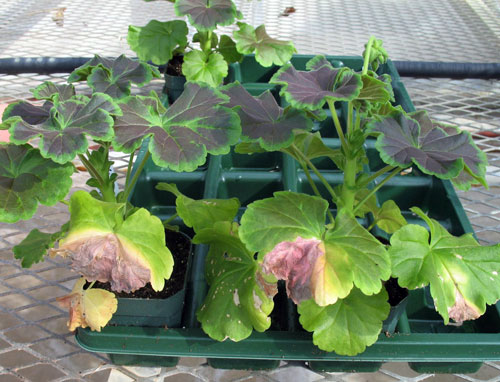Recognizing symptoms of bacterial blight of geraniums
Be proactive in managing Xanthomonas in your greenhouse to prevent geranium losses.
Bacterial blight of geraniums is caused by a specific pathovar of the Xanthomonas hortorum (formerly known as Xanthomonas campestris) pathogen and is sometimes called bacterial stem rot, bacterial wilt, or bacterial leaf spot. Xanthomonas hortorum pv. pelargonii is specific to Pelargonium and Geranium plant species. This disease is of special concern for growers because it is easily spread (by propagation, irrigation, or whiteflies), symptoms may not be visible to the naked eye until months after an infection, and once plants are infected there is no effective chemical or biological control.
Symptoms of bacterial blight may vary depending on the plant species and cultivar. When the bacteria are spread via irrigation water, or splashing, small (2-3 mm), water-soaked spots will develop first, usually beginning on the underside of the leaves and then showing through to the upper leaf surface. These spots will then turn tan to brown and will be slightly sunken with well-defined margins. Spots may then spread into wedge-shaped areas of chlorosis followed by necrosis (Photo 1). Eventually, the bacteria infect the vascular system and cause wilt of the entire plant and, finally, stem rot and plant death.

Photo 1. Xanthomonas on geranium with wedge-shaped leaf necrosis.
Photo credit: Nancy Gregory, University of Delaware, Bugwood.org
If the geranium was infected through the roots or was taken as a cutting from an infected mother plant, the first symptoms may be wilting of the lower leaves. Ivy geraniums may not exhibit the wilting symptoms, but are certainly carriers of the pathogen and symptoms may mimic nutrient deficiencies or a mite infestation. As such, it is not advisable to hang ivy geraniums above other geraniums in the greenhouse.
So, how do you manage such a disease? Your best bet is to make sure you have excellent sanitation and clean cuttings. If you use your own stock plants to propagate via cuttings, consider sending stock plant samples to a reputable lab for culture-indexing of these plants to verify that they are not carrying the disease. If you purchase cuttings, ask your supplier about their culture-indexing program and prevention practices. In addition, keeping different sources of geraniums separate from each other is also advisable. This will prevent the spread of an infection should one source discover an infection. If any plants become infected in your greenhouse, place those plants and the ones around them directly into garbage bags before carrying them out of the greenhouse and disposing of them promptly.



 Print
Print Email
Email



